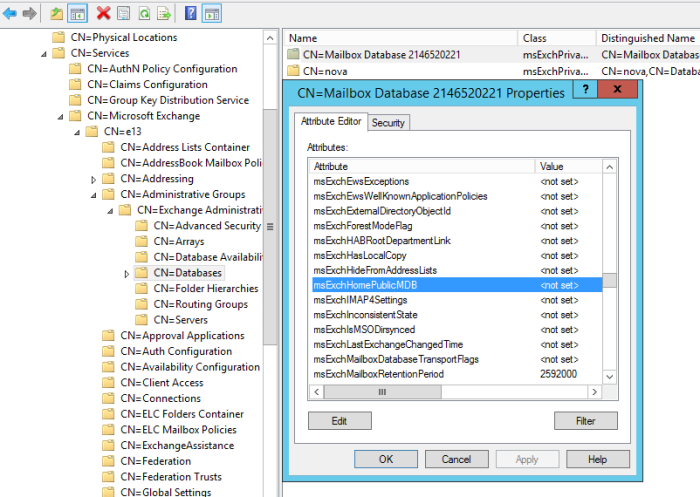Warning: with this method of Migration all PF permissions will be lost. You can export them with EXfolders but they must be added manually after that to Exchange 2013, so it is useful only if you have a small PF database.
If you for some reason cannot complete the migration as described in Technet you can export the whole PF database content to PST and import them back in newly created Exchange 2013 Public Folder Mailbox.
- You need an account with full permissions to all PF in the exchange 2010 Public folder database
- Export all the PF to one or more PSTs
- In order to create a public folder mailbox in exchange 2013, all existing legacy PF databases schuld be deleted. from ADSI or EMC mostof the cases it is not working from EMC because of various reasons so just delete it from ADSI edit.https://technet.microsoft.com/en-us/library/bb201664.aspx or
Open Adsiedit.msc-> Connect to the configuration partition.
Expand Configuration-Services-Microsoft Exchange–Administrative Groups-Servers–Information Stores.
Delete the database. - Remove the following attribut for all MailboxDatabases in the same location as above : MsExchHomePublicMDB

- Create new Public Folder mailbox on Exchange 2013 . If there is already existing PF mailboxes created by older migration attempts delete them. In ADSIedit remove “msExchDefaultPublicFolderMailbox” under “CN=e13,CN=Microsoft Exchange,CN=Services,CN=Configuration,DC=e13,DC=de”.The new mailbox schuld be created as Primary hierarchy. If this is not the case take the Mailbox GUID and set it in set-OrganizationConfig -RootPublicFolderMailbox. or in “msExchDefaultPublicFolderMailbox” after “1;1;3;36;”
- Set the mailbox and Database quotas to unlimited for the mailbox and database where the PF mailbox is located.
- Migrate the user with which you have made the export to Exchange 2013
- Run on 2013 exchange get-mailbox | set-mailbox -DefaultPublicFoldermailbox “pfmailbox”
- Use Outlook –>option–>advanced–> Export outlook Information to a File…. and choose import from pst select the “import in selection” new PF Structure in Outlook should be selected and import the PST to the new PF mailbox.
- Correct the permissions. All users schuld be granted permissions separat.
- You can use excel to open the export made with EXfolders and create Formulas to input the needed paths and user names in add-publicfoldercleintpermissions CMD led. This is hard work, but can automate the permission assigment.